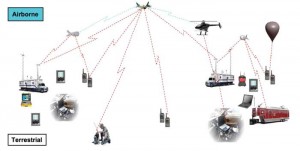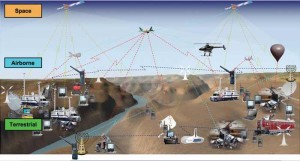A Modest Proposal
Public safety has made great strides in achieving interoperability since 9/11. The focus on interoperability also highlighted the need to maintain operability during large incidents, such as earthquakes, tsunamis and storms. The traditional approach has been to build strong infrastructure and backup systems that can ride out the incident. However, it’s clear that the power of nature can’t be completely overcome. The best human efforts could still fail in a major event. No tower is completely impervious to winds, and sometimes debris flies into generator cooling radiators and shuts down a radio system.
Most importantly, during a large-scale event, first responders’ inability to use their regular land mobile radio (LMR) handsets and mobiles means law and order, and disaster response and rescue are compromised. The citizenry is left to survive on its own. When command, control and communications (C3) are disrupted, the loss of situation awareness may result in inadequate response from federal or state government and possibly overly optimistic statements from state and national leadership.
When communications infrastructure is unavailable or disrupted in a large area, such as after the earthquakes in Japan and Haiti, first responders often turn to satellite communications (satcom). Some responders are well versed in using satcom. Firefighters working wildland fires may use satcom terminals for data, situational awareness and incident management. Often, however, those affected aren’t conversant with the use of satcom technology, especially if it’s not practiced or in regular use. Communications needs may be so great that a few satcom terminals flown in may be the only means to provide local communications.
The yeoman services provided by satcom with voice and data were critical to the early stages of recovery from Katrina. Still, the technology’s limited capacity to handle heavy traffic over large areas (spatial capacity) resulted in critical needs not being met. Even commercial terrestrial services that survive an event may not be designed to operate for extended periods after power failure.
To avoid breaking out unfamiliar equipment during a crisis, satcom must become an integral part of every emergency operation center and emergency management agency. Satcom could provide alternate live paths for command communications with state and federal administrative centers, including the governor’s office and FEMA. First responders in the field need to include satcom in training exercises. That is the only way to keep this equipment working and ensure first responders are trained to use them.
When considering disaster communications, it may be helpful to think in layers: the normal terrestrial layer (TL) with which we’re all familiar, the space layer (SL), and an airborne layer (AL), which I suggest introducing into an integrated emergency communications strategy (Fig. 1, above).
Space layer: Often the first phase of a recovery, SL usually requires specialized TL terminals. The regular terminals used most by first responders are rendered inoperable due to infrastructure damage. In the second phase, the SL will work with the AL to relay higher capacity communications (Fig. 2, left).
Airborne layer: The AL can be considered in three stages. Stage 1 consists of fixed wing aircraft that, at 20,000–40,000 feet, can initially fly above a storm and its aftermath in a station-keeping pattern. Sometimes called surrogate satellites, these planes can carry equipment that communicates with satellites and ground satcom terminals that are either in place or brought in. This allows them to aggregate the traffic and relay it through high-bandwidth connections to satellites, thus increasing spatial capacity. They have no power limit.
Depending on the LMR technology, these craft could carry LMR base stations if they can operate despite the aircraft’s high speed and attendant Doppler effects if it’s not directly overhead. They may even be able to perform airborne command post functions, much like military AWACS aircraft. However, these are specialized aircraft and will probably need to be federal or state assets. They will require refueling and frequent crew changes (Fig. 3, below).

Figure 3: The Airborne Layer Is Used with Existing Terrestrial Terminals & the Space Layer (Illustration Preston Hathaway)
AL Stage 2 could consist of stationary, lower flying, rotating wing craft (helicopters) that fly from 5,000–20,000 feet. These can be regular craft that can be quickly outfitted with LMR base stations because there’s no concern about piercing a pressure hull. Direct line-of-sight communications to these craft means their base stations can be low power. They will allow first responders to use their mobiles and handhelds immediately.
Stage 2 platforms could also carry mobile satellite equipment to relay communications out to distant emergency management agencies via the SL. Because they fly lower, their coverage is reduced, and more craft would be necessary to cover a large area, but increasing spatial capacity as a result. Finally, they could be outfitted with mesh networking equipment to connect with other craft, forming an extended network to support ground LMR communications while the initial stages of ground communications recovery are underway.
As the weather calms, new assets can be brought in. AL Stage 3 would add other craft, such as unmanned heliostats and slow-flying solar powered airplanes, that can operate for weeks, increasing capacity. Even the use of free-flying, low-cost balloons with repeaters, which can be replaced by others as they drift out of range, has been proposed. These craft can be supplemented or replaced by tethered balloons carrying lightweight base stations flying at 500 feet, or less and powered through the tether.
We now have an operational LMR system. Most importantly, first responders can use their regular mobiles and handsets, although perhaps in conventional analog mode. They can also be dispatched from fixed or mobile dispatch centers.
Power: This strategy’s less glamorous aspect is the need to keep terminals powered and operating. The restoration of the infrastructure outlined above is useless if the user terminals are dead and there’s no ground power to recharge them. Decentralized power solutions, such as solar panels, propane fuel cells and generator power, are an option. It’s estimated that a 1.2-sq.-meter solar panel can provide about 180 watts to power six handset chargers. That should be enough to serve a small first responder post. Smaller, portable units could be placed in first responders’ homes so that personnel are available for duty if their station has been damaged or destroyed, or they can’t reach it.
This approach buys time until the regular communications and power infrastructure are repaired. C3 is restored quickly in an orderly fashion. Situational awareness is maintained. Necessary aid can begin flowing in as roads are repaired. Law and order and rescue units can also function.
Implementation: What’s needed to implement this approach? The AL needs airborne assets with satellite relay capability that can work with multiple satellite types and ground terminals. These need to be stationed around the country for quick deployment by an agency, such as FEMA.
Next, lightweight portable equipment that can be quickly installed and taken up with helicopters is needed, both for satcom and LMR. These may be kept in regional centers from which helicopters can be dispatched. Low-cost, lighter-than-air craft can also be placed in regions to facilitate rapid deployment in sufficient numbers.
Finally, local agencies may keep tethered balloons as emergency backups for towers. However, because transportation infrastructure may be sufficiently restored by the time these are deployed, they could be trucked in—even in advance of a major storm. Additionally, some federal agencies, such as the DOD and the National Guard, may already have such equipment that could be used to relay civilian communications in an emergency with appropriate portable base stations, provided the necessary SOPs and MOUs are executed.
The SL could also use a small number of specialized National Emergency Communications Satellites (NECS) as national assets. Justified in the same manner as GPS or weather satellites, these are national resources. They could be made available by the federal government for use without charge. Another approach: Leverage commercial satellites, redirecting them to support emergency use in a public/private partnership. The satcom industry could cooperate with first responders to minimize tariffs while ensuring they have a steady stream of revenue supporting normal traffic between EOCs and the state. This is particularly important because operational funding to pay for satcom as part of daily activities is difficult to find.
Even in a relatively well-contained disaster area, this overall approach could be beneficial. Satcom and airborne assets could relay communications to the surrounding unaffected cities.
Although many pieces of this approach may already be present, various communications links I’ve proposed may need to be standardized. Software and middleware are needed to connect dissimilar systems together in SL, AL and some elements of TL. The Software Defined Radio Forum’s satcom and public safety special interest groups have started examining the hardware and software issues necessary to build such hybrid architectures. APCO International, the federal government and industry must provide leadership.
Other important considerations: Frequencies that could be used in airborne LMR nodes in disasters in the various bands must be designated, and airborne satcom relays licensed. These frequencies could be used after a declaration of disaster and infrastructure is down. Regulatory mechanisms for using existing ground frequencies with damaged infrastructure and mutual aid channels in low-power airborne nodes may also need to be explored. Clearly, there would be no time for specific FCC or NTIA applications and studies.
Finally, these approaches may not be useful if first responders aren’t trained to work with the multiple recovery layers before ground infrastructure is restored. Standard operating procedures and MOUs are critical. The concepts of operation need to be developed, and all parties must know the playbook to provide relief quickly.
In summary, the present ad hoc approaches to communications recovery after large incidents must be improved. Recovery should be a layered process that provides an orderly restoration of communications, and these are some of the missing pieces needed to make this happen.
About the Author
Daniel Devasirvatham, PhD, is a member of APCO International’s Standards Development Committee. He works for SAIC. Contact him via e-mail at daniel.m.devasirvatham@saic.com.
Author’s note: Special thanks to Mike Paulette, Brian Hobson and Preston Hathaway. The ideas expressed in this article do not endorse any product or vendor and are not the formal positions of any company, organization or government agency.
Originally published in Public Safety Communications magazine, Vol. 77(5):26-28, May 2011.



